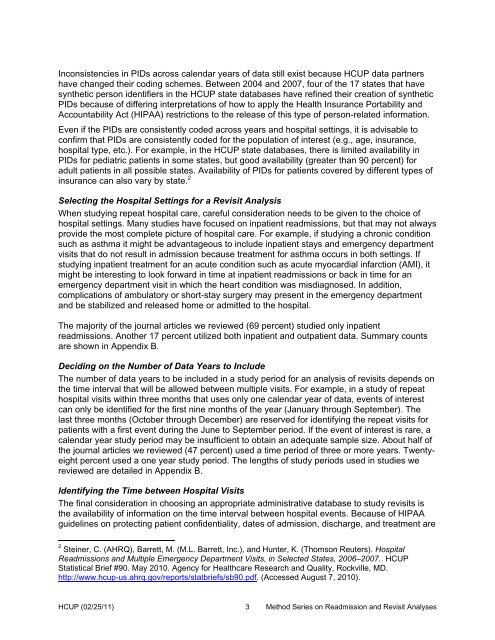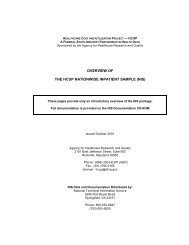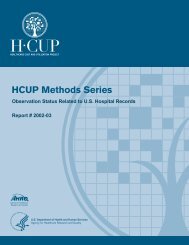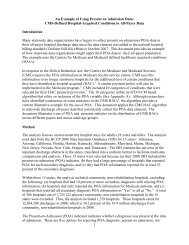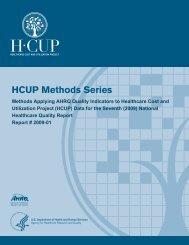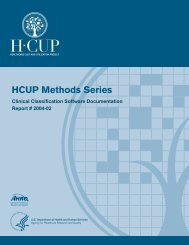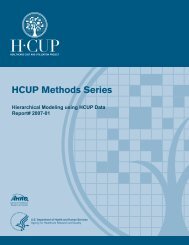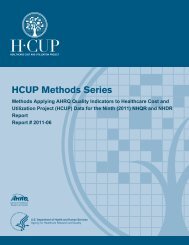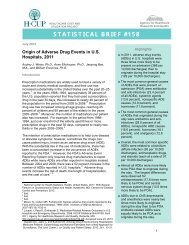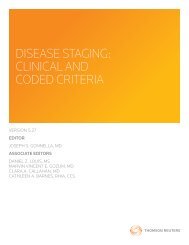Methodological Issues when Studying Readmissions and ... - HCUP
Methodological Issues when Studying Readmissions and ... - HCUP
Methodological Issues when Studying Readmissions and ... - HCUP
Create successful ePaper yourself
Turn your PDF publications into a flip-book with our unique Google optimized e-Paper software.
Inconsistencies in PIDs across calendar years of data still exist because <strong>HCUP</strong> data partnershave changed their coding schemes. Between 2004 <strong>and</strong> 2007, four of the 17 states that havesynthetic person identifiers in the <strong>HCUP</strong> state databases have refined their creation of syntheticPIDs because of differing interpretations of how to apply the Health Insurance Portability <strong>and</strong>Accountability Act (HIPAA) restrictions to the release of this type of person-related information.Even if the PIDs are consistently coded across years <strong>and</strong> hospital settings, it is advisable toconfirm that PIDs are consistently coded for the population of interest (e.g., age, insurance,hospital type, etc.). For example, in the <strong>HCUP</strong> state databases, there is limited availability inPIDs for pediatric patients in some states, but good availability (greater than 90 percent) foradult patients in all possible states. Availability of PIDs for patients covered by different types ofinsurance can also vary by state. 2Selecting the Hospital Settings for a Revisit AnalysisWhen studying repeat hospital care, careful consideration needs to be given to the choice ofhospital settings. Many studies have focused on inpatient readmissions, but that may not alwaysprovide the most complete picture of hospital care. For example, if studying a chronic conditionsuch as asthma it might be advantageous to include inpatient stays <strong>and</strong> emergency departmentvisits that do not result in admission because treatment for asthma occurs in both settings. Ifstudying inpatient treatment for an acute condition such as acute myocardial infarction (AMI), itmight be interesting to look forward in time at inpatient readmissions or back in time for anemergency department visit in which the heart condition was misdiagnosed. In addition,complications of ambulatory or short-stay surgery may present in the emergency department<strong>and</strong> be stabilized <strong>and</strong> released home or admitted to the hospital.The majority of the journal articles we reviewed (69 percent) studied only inpatientreadmissions. Another 17 percent utilized both inpatient <strong>and</strong> outpatient data. Summary countsare shown in Appendix B.Deciding on the Number of Data Years to IncludeThe number of data years to be included in a study period for an analysis of revisits depends onthe time interval that will be allowed between multiple visits. For example, in a study of repeathospital visits within three months that uses only one calendar year of data, events of interestcan only be identified for the first nine months of the year (January through September). Thelast three months (October through December) are reserved for identifying the repeat visits forpatients with a first event during the June to September period. If the event of interest is rare, acalendar year study period may be insufficient to obtain an adequate sample size. About half ofthe journal articles we reviewed (47 percent) used a time period of three or more years. Twentyeightpercent used a one year study period. The lengths of study periods used in studies wereviewed are detailed in Appendix B.Identifying the Time between Hospital VisitsThe final consideration in choosing an appropriate administrative database to study revisits isthe availability of information on the time interval between hospital events. Because of HIPAAguidelines on protecting patient confidentiality, dates of admission, discharge, <strong>and</strong> treatment are2 Steiner, C. (AHRQ), Barrett, M. (M.L. Barrett, Inc.), <strong>and</strong> Hunter, K. (Thomson Reuters). Hospital<strong>Readmissions</strong> <strong>and</strong> Multiple Emergency Department Visits, in Selected States, 2006–2007.. <strong>HCUP</strong>Statistical Brief #90. May 2010. Agency for Healthcare Research <strong>and</strong> Quality, Rockville, MD.http://www.hcup-us.ahrq.gov/reports/statbriefs/sb90.pdf. (Accessed August 7, 2010).<strong>HCUP</strong> (02/25/11)3Method Series on Readmission <strong>and</strong> Revisit Analyses


